We’ve talked about Yamaha’s HPDI (High Pressure Direct Injection) on this website before.
If you haven’t read about it here you may still be aware of the fact Yamaha owns 2-stroke DI technology and actually produced it for a number of years on its 2-stroke marine outboards.
It’s a totally different system than Ski-Doo’s DI E-TEC but produces very similar results. I’ve experienced this technology on the water and these 2-strokes are flat-out phenomenal engines and have all the desirable features of 2-stroke Direct Injection. They burn very lean, use little oil, produce almost no smoke and make great power.
Our point is this: Yamaha has been getting very serious about the mountain market the last two years. It’s MT-X line of 4-stroke Vipers is getting a lot more attention lately and its 1049cc 4-stroke triple is proving to be a decent performer in high altitude situations.
It’s doubtful, however, the MT-X will steal many Polaris, Ski-Doo and Cat 2-stroke-loving mountain hardcores away from their selected brand. You could say it’s an uphill battle (pun) for Yamaha trying to sway vertical customers into the 4-stroke genre.
A DI 2-stroke, however, would change all the rules. Remember, up until a decade ago, Yamaha was building some really awesome 2-stroke sleds. The 700cc triple in the SRX comes to mind but some of those early 600 twins were also really fast, lightweight powerplants.
Knowing how Yamaha operates, any new 2-stroke would likely be a complete new blueprint and the use of HPDI may necessitate a from-the-ground-up rejig of any engine designed for a snowmobile, anyway.
What’s even more interesting is, with the Viper, Yamaha now has a really competitive chassis to put a 2-stroke in.
Hey, maybe we’re dreaming in Technicolor here but when a company owns great technology and it’s just sitting on a shelf somewhere in Hamamatsu, doesn’t it tweak your brain to think what could be possible?








